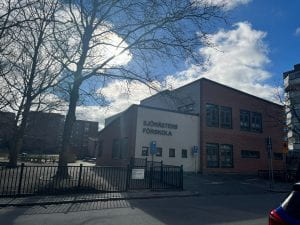We have arrived in Malmö and are getting settled into our new city where we will live for nearly 4 months. As a city planning professor, I’m constantly trying to understand urban form and transportation networks when I’m traveling. As I acclimate to a new city, I’m trying to understand when various parts were developed, how, and under what policies and laws. I’ve learned so much about the politics of Sweden and history of this city & housing in just a few short days – I’m eager to learn more.

Lugna Gatan courtyard
We are living in an apartment held by the university for visiting researchers. Our apartment is located near the center of the city, close to Strogatan (shopping street) and Triangeln (transit station and mall/shopping area.) The street where we are living is called Lugna gatan which translates to “calm street” in the neighborhood “Lugnet.”
The urban design in this area is interesting – there are several 7 story u-shaped apartment buildings with courtyards in the middle. The apartments are designed very well with tons of light in each room. While the complexes are bulky, each building is split up so there are ~28 apartments accessed through individual doors (rather than a large central entry way with long, winding hallways. Each floor has 4 apartments and the design also means few shared walls. The building is remarkably quiet. There’s shared laundry in the basement and a courtyard with a playground, bbq area, bike racks, and recycling/compost. There is a pre-school across the street. The buildings are made of brick with aluminum siding around the balconies, which gives a somewhat brutalist feel.

Outside of Lugna gatan
We assumed the buildings were constructed post-war and started doing some additional research. It turns out our apartment building is owned and maintained by MKB, which is the city of Malmö’s non-profit housing authority. We kept seeing “MKB” on apartment buildings and looked it up. Some interesting facts:
- MKB was started in 1945 as a nonprofit housing authority under the principle of “good housing for everyone.”
- In the 1960s, Sweden adopted a “Million Home Program” or Miljonprogrammet to cope with the housing shortage. The goal was to create 1 million units of housing in the country to accommodate population growth and upgrade substandard housing.
- MKB built several housing areas during this period, including Lugnet (where we are living)
- Currently, according to MKB: “With just over 25,000 apartments and over 1,000 commercial premises, we are the largest real estate company in Malmö with a value of more than SEK 40 billion. We have 32 percent of the rental market in the city and around 60,000 Malmö residents live in an MKB apartment.”

From what I can tell, you register interest in an apartment online and search vacancies through the website. There is a municipal housing agency (Boplats Syd) that aggregates apartments from MKB and other landlords. Some of the apartments have minimum income requirements, and in general, you have to earn 1.5x the rent. There are requirements about second homes, savings, debt, and number of tenants. Some also mentioned that your work couldn’t be too far from your home! One says: “You can usually have a maximum of 2 hours commuting distance one way between your work and home.” The rents are very reasonable and are set through tenant/landlord negotiations. For example, our rent for a furnished 1 bedroom, 61 sq meter (656 sq ft) is 8423 SEK (or $896 a month) including all utilities except broadband. For a nice apartment steps away from the center of city, I find this remarkably reasonable.
I found out some interesting facts about Lugnet that I’ll share in a future post after some further research. As I embark on my research project in Sweden, I want to find out more about:
- How is construction of government subsidized housing financed?
- Does the government offer both housing construction subsidy and rent subsidy?
- How is land obtained to construct housing?
- Who is eligible for government supported housing?
- How long are the waiting lists for housing? (queues)
- What are the building codes and maintenance requirements for government supported housing?
- What are the characteristics of other landlords and rents (beyond MKB?)

Interesting
Pingback: What's the real bottom line? sustainability in housing profitability - LGiU